1.22: 1990s and Early Electronic Music
- Page ID
- 168933
Green Day
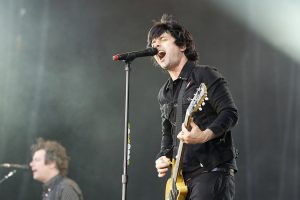
Green Day is a pop punk band that formed in California in 1987. The band is led by songwriter/vocalist/guitarist Billy Joe Armstrong. The group was a nationally popular punk groups influenced by the melodic and catchy style of the Replacements and Husker Du. Their style has been imitated by countless pop-punk groups since, specifically their use of simple chord progressions and catchy melodies. Their major label debut Dookie (1994) brought them widespread popularity and an infamous appearance at Woodstock 94. “Paper Lantern” (Listening Examples 22.1) showcases the “Buzzsaw” guitar tone from groups like Husker Du. The vocal style is a hybrid of classic monotone vocals and melodic vocals.
Phish
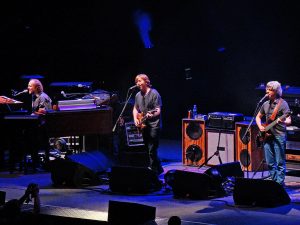
Phish formed in Vermont in 1983. The group is made up of Trey Anastasio (guitar), Page McConnell (piano), Mike Gordon (bass), and Jon Fishman (drums). All four members sing in addition to being highly skilled instrumentalists. Their style combines a dizzying amount of different musical genres such as progressive rock, psychedelic rock, funk, electronica, jazz, bluegrass, folk, and barbershop acapella into a musical kaleidoscope.
All these genres are combined with lengthy and exploratory improvisation such as the Grateful Dead had done, though Phish have forged a completely different sound than the Dead. Phish, like the Grateful Dead, are primarily known as a live band and fans will follow the band on tour. Phish gradually gained popularity through word-of-mouth. Like the Dead, Phish allowed their fans to tape their shows, and the trading of these live tapes led to new converts. In the mid 1990s they grew to become one of the most popular groups in the country with little to no help from MTV or radio. The group broke up in 2004 but reunited in 2009 and have continued to tour since then.
Dave Matthews Band
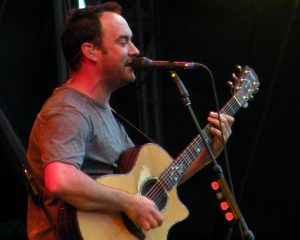
The Dave Matthews Band formed in Virginia in 1991, led by singer/songwriter/guitarist Dave Matthews. The group consists of electric violin, acoustic and electric guitar, bass, and drums. Saxophonist LeRoi Moore was an important and distinctive member of group until his sudden death in 2008.The group has an eclectic sound that combines pop, folk, jazz and other genres with live improvisation. Their jams are more tight knit and tend not to stray from the song they are playing, unlike Phish.
Matthews has an intense and dramatic vocal style, and his songwriting is unique. He is notable for the complex guitar parts he plays while simultaneously singing in unrelated rhythms, resembling the style of African griot singers. The fact that
Matthews himself is South African is notable for this reason. Some songs are energetic jam vehicles, some are whimsical folk style tunes. The group maintains an immense popularity, live and on record. They have had five consecutive albums debut at No. 1 and have sold 30-40 million records worldwide, and tour consistently.
Radiohead
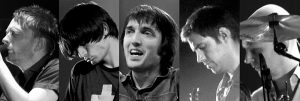
Radiohead formed in Oxford, England in 1985. The original lineup has not changed for their 20+ year existence. The group combines sophisticated avant-garde electronics with traditional rock sounds and instruments. That being said, many members are multi-instrumentalists and will play a variety of instruments on their records and on stage. Radiohead consists of Thom Yorke (vocals, guitar), Johnny Greenwood (guitar, keyboards), Ed O’Brien (guitar, vocals), Colin Greenwood (bass, keyboard), and Phil Selway (drums, percussion).
The group began as an alternative rock group with their debut album Pablo Honey (1993) using lyrical themes of angst and alienation. This continued through to their third album, OK Computer (1997) which also saw the incorporation of more electronic sounds, something which has continued to evolve on their subsequent releases.
Listening Examples 22.1
Green Day: “Paper Lanterns”
Phish: First, listen to “Down With Disease.” Then, listen to an example of the improvisation of Phish. The 18 minute version of the song “Twist” showcases a minimalist approach to jamming in which a drum groove is maintained for the duration of the improvisation. The other instruments come up with ambient sounds and repeated melodies or gestures that evolve slowly over time. As the jam goes on, the sounds become more noisy and less melodic, resembling the complexity of an orchestra. Notice how the lights interact with the music in the moment.
Dave Matthews Band: First, listen to DMB’s version of “Satellite”. To illustrate the intricacy of the guitar part to “Satellite”, I demonstrate the bass line and melody in isolation, then I play the full part. See if you can identify the bass line and the melody when I play the full guitar part.
Radiohead: “No Surprises”
Developments in Hip Hop
By the early 1990s Hip Hop was a well established musical style growing in popularity. At the same time, different branches of hip hop were emerging utilizing
ever more diverse musical inspirations. Some hip hop began using the music as a way of expressing ideas of peace and love, concepts more common in soul music and 1960s pop. Arrested Development is a prime example of this approach, and their positive hip hop found new listeners that didn’t necessarily enjoy or identify with hip hop groups such as NWA. Some groups began fusing hip hop with other musical styles such as heavy metal and hard rock. Bands like Rage Against the Machine, Beastie Boys, and Red Hot Chile Peppers blended, in varying ratios, elements of rock such as live instruments like distorted guitars and aggressive drums instead of samples and electronic beats.
Arrested Development

Arrested Development was a hip hop group that formed in 1988. The sound of the group stood in stark contrast to the Gangster Rap which was extremely popular in the early 1990s. The group rapped about topics like spirituality, love, and peace. The music usually retained funk-esque beats/backdrops common in hip-hop, while including members who sang and rapped, as well as a mix of men and women members. They also came from an Afro-centric perspective, often including African folk percussion and vocal stylings.
The Beastie Boys
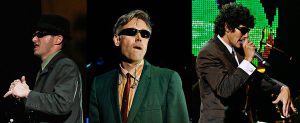
The Beastie Boys formed in 1981 in New York City beginning as a punk group but transitioning to hip hop by the mid-1980s. They became one of the biggest selling hip-hop groups of all time. Their music often combines hip hop beats and samples with live instruments reflecting their rock roots such as distorted electric guitars and live drums.
Listening Examples 22.2
N.W.A.:“Straight Outta Compton” (1988)
Arrested Development:“People Everyday” (1992)
Beastie Boys:“So What Cha Want” (1992)
Nas: “Life’s a Bitch” (1994)
A Tribe Called Quest: “Electric Relaxation” (1994)
Notorious B.I.G.: “Juicy” (1994)
Rap and Metal Fusion
Rage Against the Machine
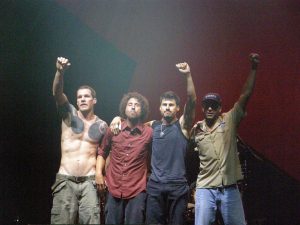
Rage Against the Machine formed in 1991 in Los Angeles. The band combines hip hop and metal with political and socially-conscious lyrics often critical of the United States government policies, both foreign and domestic. Zach de la Rocha (vocals)
brings the hip hop element through his rapped vocals, while the band creates a heavy, riff-based sound which includes the unorthodox guitar style of Tom Morello. Morello creates new sounds on his instrument including an emulation of the turntable scratching of DJs. Lyrically the song is political: a paranoid vision of a corrupt government suppressing free speech and a military-industrial complex running rampant.
Listening Examples 22.3
Rage Against the Machine: “Bulls on Parade” (1996)
Electronic Music: Origins
Electronic music uses sounds that originate from electronic instruments, recorded and manipulated tape sounds, and synthesized sounds. The origins of electronic music lie largely in the works of 20th c. classical composers such as Pierre Schaeffer (pictured above) and Karlheinz Stockhausen. Composers used early synthesizers to create electronic timbres and blended those sounds with acoustic instruments and “non-musical” sounds to create “Music Concrete”, a term coined by composer Pierre Schaeffer literally translated as concrete music or music that is permanently documented as a “performance” on tape, set in stone for all time.
We have discussed Music Concrete already in class when we looked at the music of Pink Floyd, for example. In that instance, non-musical sounds such as cash registers, coins, speech, and clocks ticking were used throughout the album Dark Side of the Moon (1973). In most cases, these sounds were used as transitions between songs, but created an interesting and unorthodox sound environment for a rock album.
Composers like Pierre Schaeffer use these sounds as the basis for entire compositions. For example, in the first of five pieces using music concrete titled “Etude aux Chemins de Fer” from 1948, Schaeffer recorded a variety of sounds emanating from trains including whistles, screeching, and the rhythmic shuffle of the train’s movement. These recordings were then manipulated in a variety of ways, ultimately organized into a final form (Concrete music!). Schaeffer uses tape looping throughout the work, which involves repeating a particular sound multiple times to create a sense of cohesion, a feeling of a musical phrase, and sometimes to create a rhythmic pulse.
Raymond Scott
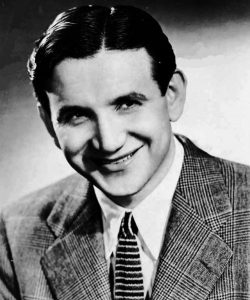
Raymond Scott – (1908-1994) was an American composer of classical, jazz, and electronic music. Scott began focusing on electronic music in the 1940s-50s. He composed music used in a variety of applications including film, commercials, music for soothing babies, and cartoons. Much of his electronic music involves synthesizers, some of which were invented by Scott himself. Rather than music concrete, which involves recording and then manipulating those sounds electronically, synthesis
involves electronics from the start. A synthesizer is an instrument that generates sound purely electronically; it has no acoustic properties. The result is that in early synthesizers the sound was completely foreign to listeners. Later on as synthesizer technology developed, certain manufacturers began developing synthesizers that could emulate acoustic instruments. Scott was also important in the development of sequencers, devices which could be programmed with data that transmitted a musical sequence (melodic and/or rhythmic) to a synthesizer.
Scott composed one of his best known pieces, “The Toy Trumpet”, as a piece for jazz band in the 1930s to showcase the trumpet through a series of sections that undergo a variety of changes, with catchy melodies strung throughout the piece. Decades later Scott chose to arrange this work for synthesizers, drastically altering the sound and mood of the original with the new, futuristic timbre of early synthesizers. Both can be found in Ch. 22 Listening Examples.
Kraftwerk
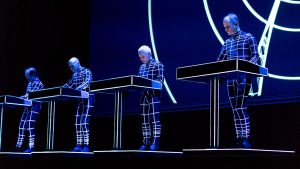
Kraftwerk is an electronic music group from Germany that formed in 1970. They are credited with popularizing electronic music.The sound of the group began as experimental, improvised rock music, but eventually grew into the electronically-based sound they are known for. They developed a bleak, robotic image and sound
that inspired groups such as Yellow Magic Orchestra. Their sound is almost purely electronic; even vocals are usually processed electronically in some way. In the 1970s, the group utilized the latest technologies including synthesizers and custom electronic percussion instruments. The group continues to perform to the present day.
“Autobahn” (1974, found in Ch. 22 Listening Examples) features mostly electronic sounds and emulates the free feeling of driving fast down the highways of Germany (The Autobahn). There are two primary sections that alternate, A being vocal-based and B being instrumental with an element of improvisation. The entire piece is quite long but the group released a shorter, radio-friendly version as well.
By the late 1970s and early 1980s, Kraftwerk had fully matured and developed their approach which had essentially become entirely electronic. The music became less wandering/experimental and had crystallized into shorter pieces, occasionally providing melodic hooks as in the case of “Pocket Calculator” (1981, found in Ch. 22 Listening Examples).
Listening Examples 22.4
Pierre Schaeffer:“Étude pathétique”, the fifth of the 5 short pieces using music concrete. Schaeffer uses sounds like speech and coughing to creating repetitive rhythmic pulses.
Karlheinz Stockhausen:“Studie I” (1953)
Gyorgy Ligeti:“Artikulation” (1958) complete with sychronized visual score
Raymond Scott:
- “Toy Trumpet” Original Version
- “Toy Trumpet” Electronic/Synth Version
- “Lightworks”
Kraftwerk:
Synthpop
Yellow Magic Orchestra
The group Yellow Magic Orchestra formed in the late 1970s by Haruomi Hosono (from the band Happy End) and combined elements of pop music (including J-Pop) with electronic music to create synthpop. Electronic music had been explored by groups in Europe such as Kraftwerk, but Yellow Magic Orchestra brought a positive and joyous edge to the genre. Their music is often dance-oriented and nearly always fully electronic in timbre, though occasionally acoustic instruments are used to supplement the electronic sounds. The music was inspired by video game and computer game music as well, and served to inspire future video game composers.
The song “Firecracker” (found in Ch. 22 Listening Examples) opens with one minute of synthesized sounds arranged in a seemingly random way before the main part of the music begins. Many of these sounds, realized on 1970s synthesizers, would form the basis of early video game music. The piece is danceable, melodic and catchy, and resembles mainstream pop music in most ways. “Rydeen” (found in Ch. 22 Listening Examples) featuring an augmented ensemble consisting of guitar, drums, and four synthesizer players. The overall effect is a dense polyrhythmic texture with multiple complementary lines, very much like classical orchestral music.
Aphex Twin
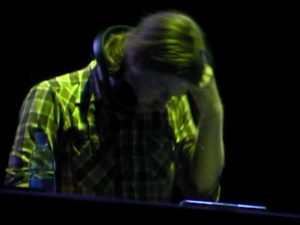
Richard D. James, better known by his stage name Aphex Twin, is a composer of electronic music. The music of Aphex Twin explores ambient dream-like textures, the dance-based electronic genres techno and electronica, glitch and noise, and rock/metal. His music brought a new level of experimentation, creativity and craftsmanship to the genre of electronica. His composition “Come To Daddy” blends fast tempos, electronic beats, a heavy distorted riff and distorted vocals singing darkly humorous and simple lyrics. The piece was intended as a parody and unintentionally became one of Aphex Twin’s most popular compositions.
Listening Examples 22.5
Yellow Magic Orchestra:
Brian Eno:“Discreet Music” full album
Juan Atkins/Cybotron: “Clear”
Aphex Twin:
- “Come to Daddy” (Music video)
- “Xtal”, the opening track from Aphex Twin’s debut lp Selected Ambient Works 85-92 is much more representative of his style: a blend of ambient electronic textures and danceable beats.


